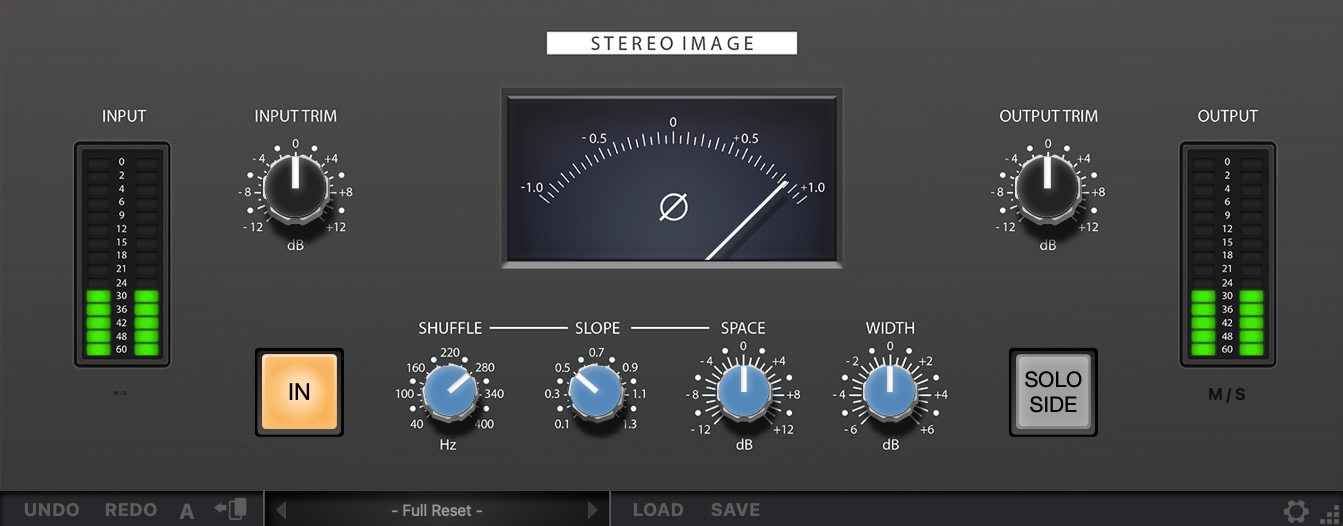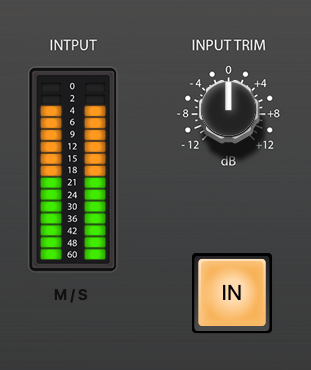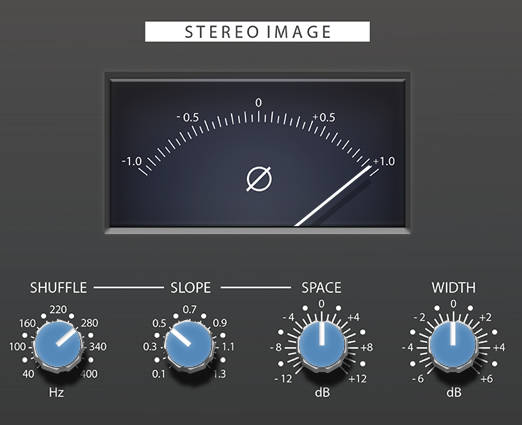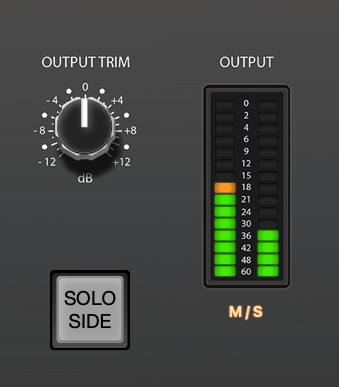Spatial manipulation of the stereo field.

FUSE STEREO IMAGE
The RRS FUSE Stereo Image developed for spatial manipulation of the stereo field.
Based on a concept that has roots in EMI engineer Alan Blumlein’s invention of modern stereo in 1931: Stereo Shuffling.
INTERFACE CONTROLS

Input Meter
Segmented metering showing the input level.
Mid/Side Monitoring
Switches the input meter to show mid signal on the left, and the side signal on the right.
Input Trim
Applies gain to the input signal.
IN (Plug-in Bypass)
The IN switch located in the Input section provides an internal plug- in bypass. This allows for smoother In/Out comparisons by avoiding the latency issues associated with the host application’s Bypass function. The button must be ‘lit’ for the plug-in to be in circuit.
Phase-correlation meter
The phase correlation meter is a standard correlation meter tool to monitor the phases (and potential phase problems!) of your stereo mix/signal.
-1 means your mix/signal is “out of phase” (180°). +1 means your mix/signal is “in phase” (0°).
0 (zero) means that there is either:
• no signal present
• signal present on only one channel
• phases of L&R channels are shifted exactly 90°.
Shuffle
Changes the cut-off frequency for the 'SPACE' control.
Slope
Changes the quality factor for the 'SPACE' control.
Space
Broadly boosts or cuts bass frequencies, based on the 'Stereo Shuffling' technique.
Width
Widens or narrows the stereo image by applying a gain to the side signal. Sweet spot is between +2 and +4 dB!


Output Trim
Applies gain to the output signal.
Solo Side
Listen only to the side (stereo image) of the signal.
Output Meter
Segmented metering showing the output level.
Mid/Side Monitoring
Switches the output meter to show mid signal on the left, and the side signal on the right.
TOOLBAR PANEL
Undo/Redo
Undo and Redo functions allow undo and redo of changes made to the plug-in parameters.
A/B
A/B buttons allows you to load two independent settings and compare them quickly.
Preset Display
Factory presets are included in the plug-in installation, installed in the following locations:
Mac: Users\[user name]\Music\Red Rock Sound\RRS Fuse Stereo Image\Patches
Windows: C:\Users\[user name]\Documents\Red Rock Sound\RRS Fuse Stereo Image
You can save the current Comp settings as the Default preset. - Full Reset – is the default preset
Load
Load button allows loading of presets not stored in the locations described above.
Save
Save button allows for save of user presets.
«?»
? button opens info page.
D3D / OGL / CPU (Windows)
This switch allows you to choose between GUI rendering engine:
Normally, no need in switching rendering mode manually, plug-in try to initialize D3D9 then OGL (if D3D9 failed) and CPU (if OGL failed) automatically. But if you have problems with the GUI, you can manually switch and test different rendering methods at work.
This switch is available only in the Windows version of the plugin. For the Mac version, this is not necessary.
System requirements
All Red Rock Sound products require a computer with appropriate DAW host software (none of which are included).
Plug-in Activation requires Internet connection!
You can go offline as soon as plug-in is successfully activated.
Versions from 1.0.0 and newer of the Red Rock Sound plug-ins have the following minimum requirements:
Mac OS X 10.14.6 or higher for AU.
Mac OS X 10.14.6 or higher for VST.
Mac OS X 10.14.6 or higher for AAX. Latest version of iLok license manager.
Windows 7 or higher (Windows XP not tested).
Mac: Intel Core i3 / i5 / i7 / Xeon / Full Apple silicon support (M1 or higher).
Windows: Intel Core i3 / i5 / i7 / Xeon / AMD Quad-Core or newer.
In theory, any AAX, VST, VST3, AUv3 compatible host application should work. However, due to plug-in host differences between DAWs - and our own rigorous testing standards - we only officially test our plug-ins and instruments in the most recent versions of Pro Tools, Logic Pro, Cubase, Ableton Live, Studio One, Reaper, and Bitwig. Red Rock Sound plugins are not tested in non-listed systems, but they most likely work as long as the system requirements are met. We cannot guarantee a solution for issues in unsupported systems.